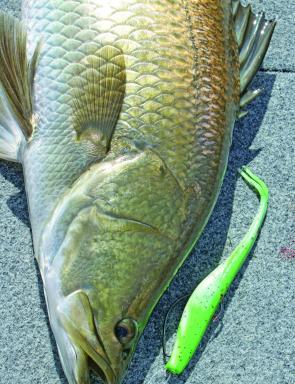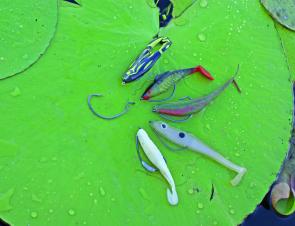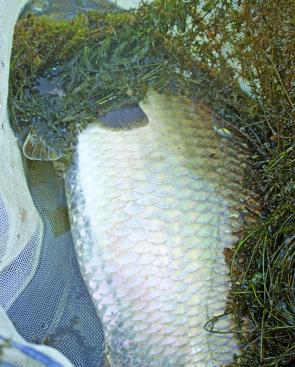Impoundment barra fishing without weed is like motocross without mud, football without grass and cricket without a pitch – they go together hand-in-hand. Weed is part of the environment that our chosen sport revolves around and, like in any other sport, the competitor must use the environment to their advantage.
Living around weed has many advantages to barra of all sizes. Once barra are released as fingerlings into a lake, the first instinct for most barra is to seek shelter in the weed. In there, they can feed, travel, school and rest with some hope that their hungry uncle won’t be able to chomp on their backside.
As a juvenile, the weed bed supplies enough food to support a huge metabolism that allows barra to grow quickly. As a mature fish, the weed beds then supply an ambush point to pluck out the larger baitfish, and also provide warmth and more oxygenated water, which are little pieces of paradise when the water quality and temperatures are poor.
Fishing around the weed with normal lures can be very frustrating. This has driven many anglers to turn to their favourite plastics and try and rig them up weedless, making them fishable in the shallowest of weed.
Weedless plastics mainly rely on the principle of hiding the point of the hook. This allows the lure to be worked on and through the weed without getting weed lodged on the hook. This means that the lure can swim freely for the whole length of the cast, therefore increasing the chance of drawing in the fish.
Likewise, weed guards are a small piece of wire that can be used to keep weed away from the hooks. This method isn’t that successful in very thick weed but works well over lily pads and patchy weed. Weedless lures have a very natural look and action in the water because there is often no backbone inside a weedless plastic allowing the lure to swim freely.
The only problem with weedless lures is the hook up rate. Since the point of the hook is actually hidden within the lure, a barra has to fully inhale the lure then close its mouth for the hook to penetrate. Since most weedless lures are made from soft plastics, they feel relatively real, which makes a barra hold on to it longer often giving you the chance to set the hooks properly.
The length of time a soft plastic is in a fish’s mouth can be greatly increased by the use of scented plastics or using scents on unscented plastics.
Once a fish is hooked with a weedless lure, you will have a better chance of landing it than if you were using a lure with two or three trebles. As many anglers know if given the chance a barra will fight dirty and that means swimming into the nearest structure.
Whether the structure is weed, timber or rock the barra will know it’s there and since there is only a single hook which is joined to the fish’s lip, it leaves little chance for the lure to become lodged on the structure and the fish escaping. Also because the lure maybe within the fish’s mouth, and the wrestle between you and the fish may include a clump of weed, strong abrasion-resistant leader is recommended.
During the cooler months, barra can be found up in the weed beds searching for warmer water. In the extremes of winter cold snaps, barra can be found on these weed beds for weeks at a time. They feed and rest deep among the weed, only retreating to the deeper water when the sun is too hot or when danger comes upon them. This is when weedless plastics come into their own.
Weedless plastics are often lighter and softer lures that do not make a large splash and commotion when cast into the water. This is very important in the shallower water as these fish are very flighty and the slightest noise may cause the barra shoot off into the deep.
During the warmer months, barra can be found around the deeper edges of the weed. This allows the fish to stay cool when the water is too hot by heading to deeper water but still gives them access to the array of food swimming amongst the weed. A weedless plastic can still be used in this situation. All that is needed is something to draw a barra up. This could be a shimmer, splash or just erratic movement.
Weedless plastic are unique in the fact that they can be custom to suit any situation, and every time you rig one up it will be different to the last. Weighted hooks, bullet sinkers and hidden weights can be all added to your plastics to adjust how fast your lure sinks or suspends to suit the depth of water you’re fishing.
One thing that many people don’t know is that the position of the weight in weedless plastics is very important as it affects its cast ability and also the way the lure glides. If the weight is in the front of a lure, when twitched it will often glide forward and downwards. If the weight is in the middle of the lure and the lure is twitched it will often glide forward and upwards. When the weight is located at the rear of the plastic (not common) the lure generally will have trouble gliding. This is only applicable to weedless plastics that require twitching.
Even though many lures need some sort of weight on them to give a straight vibration action, other lures work better with no weight as it allows free and natural movement, which gives the angler complete control of the lures movements.
Most plastics on the market can be rigged up so they are weedless, but many will lose up to half their action because of the missing weight. The lures that do work well weedless are often longer and thinner. This allows them to still remain quite soft and therefore freeing up the action.
Berkley Gulp Jerkshads have been around for a couple of years now and although most people know of their success in impoundments, they are still not commonly used. This is a real shame as this lure has an amazing natural movement and is almost perfect weedless.
These are scented plastics, meaning they are purchased in a liquid scent that actually attracts fish. This means that there is no need for extra scents and your lure swims, looks and even tastes like the real thing, which gives you an advantage.
Another Berkley product that has taken off is the Hollow Belly. These shad style swimbaits have a long paddle-tail that allows the lure to swim at any speed. This comes in handy when the fish are a bit sluggish in and around the weed as they will hang around the fish’s strike zone long enough to draw strikes.
These plastics swim best with a little extra weight either by adding small bullet sinkers or adding sticky weight.
Squidgy fish are also effective rigged weedless. These lures have a very natural profile and come in a wide range of natural colours that look amazing in the water. The knuckle before the tail can be trimmed so it is thinner to give the lure more action.
These lures, along with the Hollow Belly, are unscented plastics when purchased so adding scent can greatly increase strike and hook up rate.
Squidgy fish swim well with no extra weight but if you do add weight you can work the lure over deeper or patchier weed.
These are only three of the most popular rigs. Nearly all soft plastics could be rigged up in a way so that the point of the hook is either hidden or covered. There are no rules in how to set up your plastics and only by trial and error can a perfect rig for a certain situation be found. So use your imagination next time you’re rigging up to go impoundment barra fishing because there is no better feeling then when one of your own personal tactics pays off big.
Facts
Weedless lure guide
LureRigRetrieve
| Horny Toads | Worm hook, weighted | Constant, medium/fast |
|---|---|---|
| Jerk Shad | Worm hook, weighted/unweighted | Short jerk/twitches and pauses |
| Squidgy Fish | Worm hook, weighted/unweighted | Constant, slow/medium and pauses |
| Boof Frog | Worm hook, weighted | Constant, fast |
| Hollow Belly | Worm hook, unweighted, hidden weight/ | Constant, slow/medium and pauses |

A barra tailing on a shallow weed bed is the perfect target for weedless lures.

Kerrin Taylor with a decent 1m+ barra caught from a shallow weeded bay at Kinchant Dam.

Natural colours and pre-scented lures make weedless lures a good option in any situation.

The author with a healthy weed dwelling barra taken on a Zoom Horny Toad over very thick weed.

The most popular five plastics rigged up off weighted and un-weighted worm hooks.

This is normally the end result of a barra hooked in shallow weeds – one barra and a whole lot of weed!

Weedless lures look so realistic and tasty they fool even the smallest barra. This Jerk Shad is over half the length of the barra.




